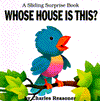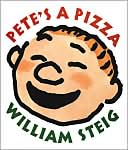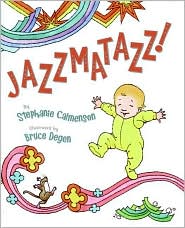Fingerplay: Little Raindrops
This is the sun, high up in the sky. (Form large circle with arms up)
A dark cloud suddenly comes sailing by. (Move hands through the air in a parallel motion.)
These are the raindrops, pitter, pattering down. (Bring arms down, flutter fingers)
Watering the flowers, growing on the ground. (Cup hands to form flowers.)
Activity: Make a book based on this fingerplay. Use the pattern here (Little Raindrops Booklet pattern) to represent the items in the fingerplay. There are four pages for your book (one for each line of the fingerplay). The pattern is a Word document so you can change the size of the objects to save paper, if you wish. The children cut out the pictures. They can cut around them to make it easier. The adults write the words to the fingerplay on each page. For children too young for this craft, the adults make the book FOR their young children. The umbrella can be used on the cover of the book.
Early Literacy Aside--Empower: Making a book with or for your child is very special. By showing care in making them and including your child in the process you make this activity around a book enjoyable. Your child can memorize the words to the rhyme and can "pretend" read it to you. Praise your child. This helps develop print motivation, a child's interest and enjoyment of books and reading. OR Making a book with your child shows them how books work. This helps them with print awareness, how to handle a book, which will get them comfortable with using books as they learn to read. Submitted by Jaime Duval and Whitney Whitaker, Radford (VA) Public Library

 Early Literacy Aside--Explain: Today I'll be pointing out some activities we are doing that support ealry literacy in the area of vocabulary. This is the term that researchers give to knowing the meanings of words. You can see what we do here in storytime and you may get some ideas of what you can do with your children throughout the day.Read the book Who Is Driving? by Leo Timmers. Pause occasionally to talk about a picture and ask what they see in the picture. Add a word or two, synonyms to the words in the the book, the children might not know.
Early Literacy Aside--Example: As you can see, I don't just read the book. We talk about the pictures and ask questions. Allow time for your child to say something back, even if you don't understant exactly what they say. You can see I added in a couple of unfamiliar words too.
Early Literacy Aside--Empower: Our youngest children learn words that name things they can see (pig, tractor, hippopotamus). As children get older they understand words for feelings and concepts, and older still, they understand words for ideas. It is good to expose even young children to all kinds of words, but they will understand the words for things they can see first.
Early Literacy Aside--Explain: Today I'll be pointing out some activities we are doing that support ealry literacy in the area of vocabulary. This is the term that researchers give to knowing the meanings of words. You can see what we do here in storytime and you may get some ideas of what you can do with your children throughout the day.Read the book Who Is Driving? by Leo Timmers. Pause occasionally to talk about a picture and ask what they see in the picture. Add a word or two, synonyms to the words in the the book, the children might not know.
Early Literacy Aside--Example: As you can see, I don't just read the book. We talk about the pictures and ask questions. Allow time for your child to say something back, even if you don't understant exactly what they say. You can see I added in a couple of unfamiliar words too.
Early Literacy Aside--Empower: Our youngest children learn words that name things they can see (pig, tractor, hippopotamus). As children get older they understand words for feelings and concepts, and older still, they understand words for ideas. It is good to expose even young children to all kinds of words, but they will understand the words for things they can see first. Aside: As your baby begins to talk, respond by elaborating on what he says. For example, if your baby points to a picture and says "cat" respond by saying, "Yes, that's a little cat with orange fur." Talking about the picture even if your baby doesn't understand everything also helps build your child's vocabulary. For example, you could say, "Look, the two kittens are playing with the string. They are having fun together."Submitted by Cindy Christin, Bozeman (MT) Public Library
Aside: As your baby begins to talk, respond by elaborating on what he says. For example, if your baby points to a picture and says "cat" respond by saying, "Yes, that's a little cat with orange fur." Talking about the picture even if your baby doesn't understand everything also helps build your child's vocabulary. For example, you could say, "Look, the two kittens are playing with the string. They are having fun together."Submitted by Cindy Christin, Bozeman (MT) Public Library Early Literacy Aside--Example: Board books are a great investment for babies! They allow babies to handle books freely, and even chew them. Good first choices are board books with pictures of everyday things. Try pointing to the pictures and then to the real objects around you.This helps babies get the idea that pictures and words are symbols for real things, a basic concept for later reading.Share a board book of your choice.
Early Literacy Aside--Example: Board books are a great investment for babies! They allow babies to handle books freely, and even chew them. Good first choices are board books with pictures of everyday things. Try pointing to the pictures and then to the real objects around you.This helps babies get the idea that pictures and words are symbols for real things, a basic concept for later reading.Share a board book of your choice. Early Literacy Aside--Empower: Rhymes help teach "phonological awareness," an awareness of the sounds that make up words. You may have noticed that your child enjoys the way a nursery rhyme sounds even if it doesn't make much sense to him. When you introduce a new rhyme or song, repeat it at least twice. Three times is even better. And be sure to keep repeating the old, familiar rhymes too.
Submitted by Cindy Christin, Bozeman (MT) Public Library
Early Literacy Aside--Empower: Rhymes help teach "phonological awareness," an awareness of the sounds that make up words. You may have noticed that your child enjoys the way a nursery rhyme sounds even if it doesn't make much sense to him. When you introduce a new rhyme or song, repeat it at least twice. Three times is even better. And be sure to keep repeating the old, familiar rhymes too.
Submitted by Cindy Christin, Bozeman (MT) Public Library Early Literacy Aside--Explain: Singing songs is one good way for children to become aware of the different sounds that make up words. We call this phonological awareness. Singng helps them get a feel for the rhythm of language and how words are divided into syllables because there is a different note for each syllable. This will help them sound out words when they learn to read.
Submitted by Cindy Christin, Bozeman (MT) Public Library
Early Literacy Aside--Explain: Singing songs is one good way for children to become aware of the different sounds that make up words. We call this phonological awareness. Singng helps them get a feel for the rhythm of language and how words are divided into syllables because there is a different note for each syllable. This will help them sound out words when they learn to read.
Submitted by Cindy Christin, Bozeman (MT) Public Library Early Literacy Aside--Explain: There are many ways we can help children enjoy books as we share books together. Children who have positive experiences around books and reading are more likely to stick with learning to read even when it is difficult. I'll be pointing out some ways to share books to make it enjoyable.
As you read the book have children repeat the phrase, "I do. I'm a . . . " with each animal.
Early Literacy Aside--Example: Having the children participate by guessing the animals and responding when the animal appears helps them enjoy the book. This helps support their print motivation.
Early Literacy Aside--Explain: There are many ways we can help children enjoy books as we share books together. Children who have positive experiences around books and reading are more likely to stick with learning to read even when it is difficult. I'll be pointing out some ways to share books to make it enjoyable.
As you read the book have children repeat the phrase, "I do. I'm a . . . " with each animal.
Early Literacy Aside--Example: Having the children participate by guessing the animals and responding when the animal appears helps them enjoy the book. This helps support their print motivation. Early Literacy Aside--Example: I am going to read one of my favorite children's books. I love reading this book; it is a lot of fun. When reading with your children, choose books YOU enjoy. Your child picks up on your feelings and understands the enjoyment of books and reading. This supports print motivation, a love of books.Read the book Pete's a Pizza by William Steig putting motions to the words.
Early Literacy Aside--Example: I am going to read one of my favorite children's books. I love reading this book; it is a lot of fun. When reading with your children, choose books YOU enjoy. Your child picks up on your feelings and understands the enjoyment of books and reading. This supports print motivation, a love of books.Read the book Pete's a Pizza by William Steig putting motions to the words. Early Literacy Aside--Example: What a fun and noisy book this is! Listen to the different kinds of sounds that music can make like plink, plink and bang-a-bang along with the jazz rhythm of Doo-dat, diddy-dat, diddy-dat, doo! As children learn to hear and make not only animal sounds but sounds of many different things, they are developing phonological awareness which will later help them sound out words as they learn to read.
Early Literacy Aside--Example: What a fun and noisy book this is! Listen to the different kinds of sounds that music can make like plink, plink and bang-a-bang along with the jazz rhythm of Doo-dat, diddy-dat, diddy-dat, doo! As children learn to hear and make not only animal sounds but sounds of many different things, they are developing phonological awareness which will later help them sound out words as they learn to read.